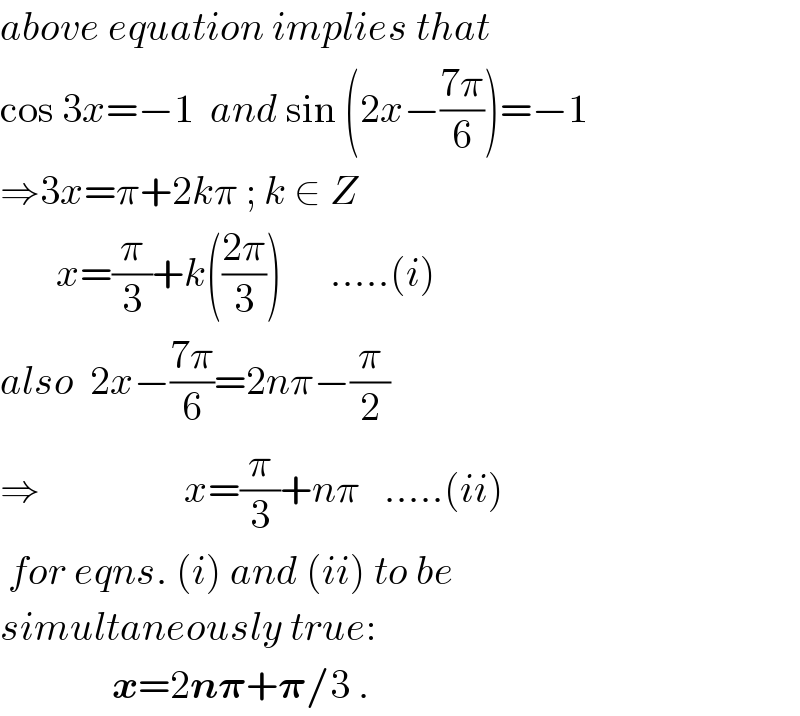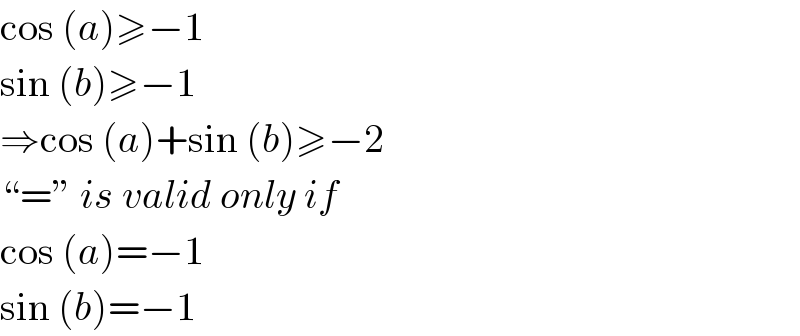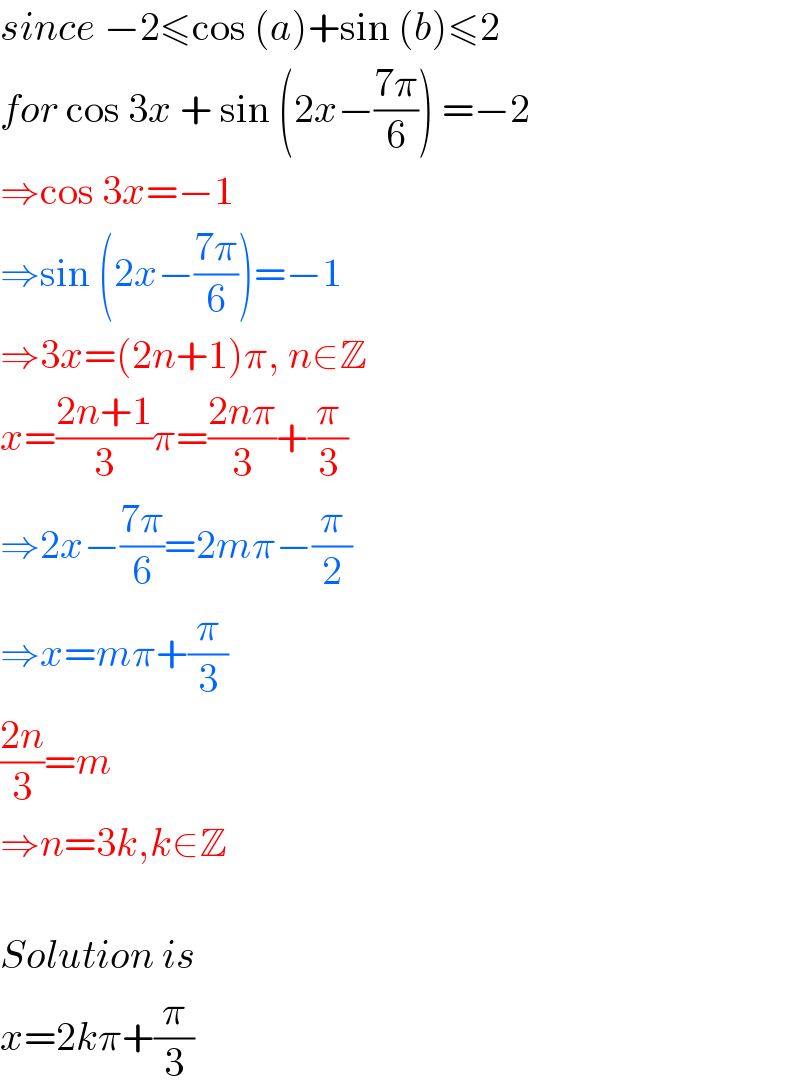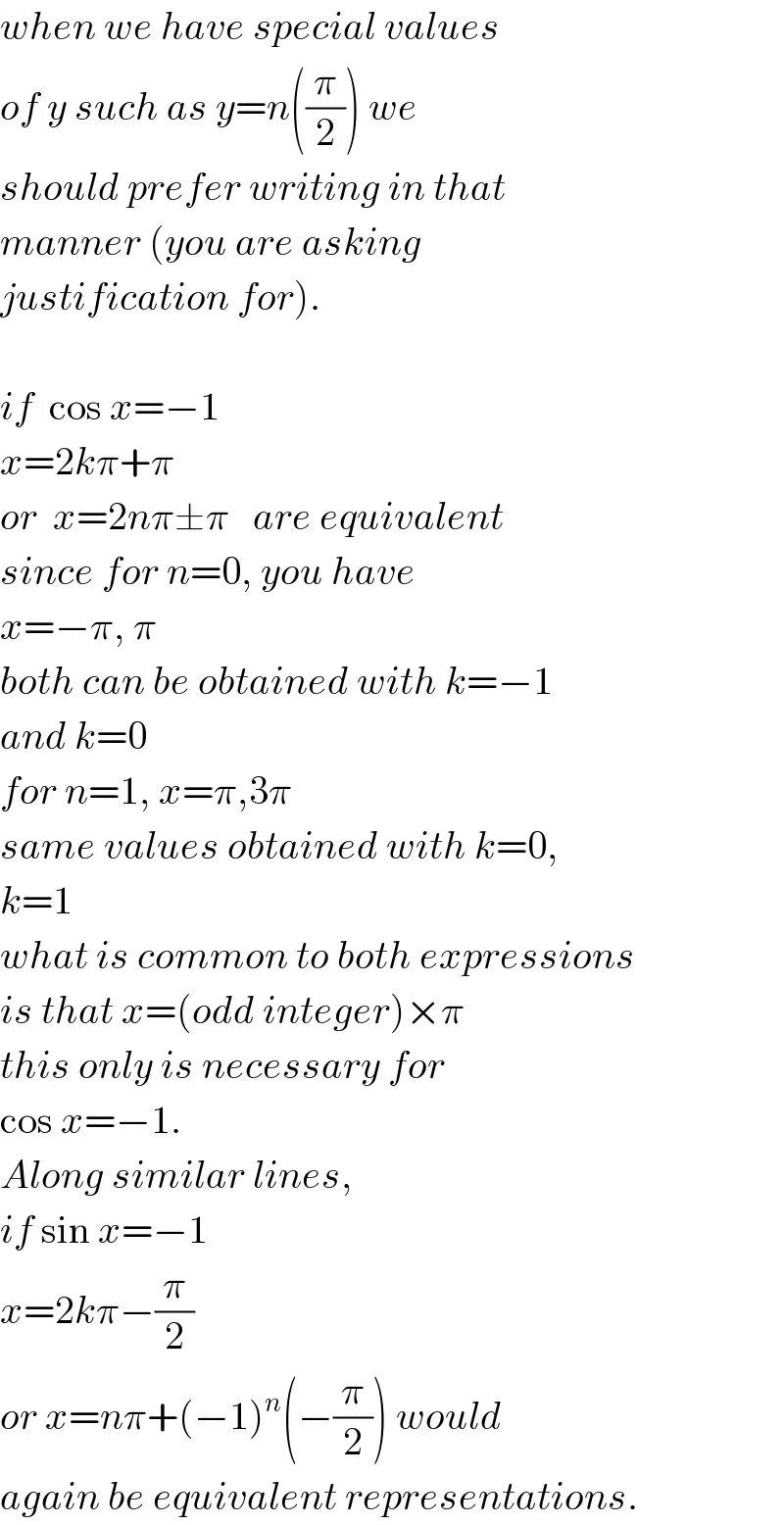
Question Number 14078 by Tinkutara last updated on 27/May/17

Commented by b.e.h.i.8.3.4.1.7@gmail.com last updated on 27/May/17

$$\mathrm{4}{cos}^{\mathrm{3}} {x}−\mathrm{3}{cosx}−\sqrt{\mathrm{3}}{sinx}.{cosx}+{cos}^{\mathrm{2}} {x}−\frac{\mathrm{1}}{\mathrm{2}}=−\mathrm{2} \\ $$$$\mathrm{8}{cos}^{\mathrm{3}} {x}+\mathrm{2}{cos}^{\mathrm{2}} {x}−\mathrm{2}\sqrt{\mathrm{3}}{sinx}.{cosx}−\mathrm{6}{cosx}+\mathrm{3}=\mathrm{0} \\ $$$${cosx}={t}\Rightarrow \\ $$$$\mathrm{8}{t}^{\mathrm{3}} +\mathrm{2}{t}^{\mathrm{2}} −\mathrm{6}{t}+\mathrm{3}=\mathrm{2}\sqrt{\mathrm{3}}{t}\sqrt{\mathrm{1}−{t}^{\mathrm{2}} } \\ $$$$\mathrm{64}{t}^{\mathrm{6}} +\mathrm{4}{t}^{\mathrm{4}} +\mathrm{36}{t}^{\mathrm{2}} +\mathrm{9}+\mathrm{32}{t}^{\mathrm{5}} −\mathrm{96}{t}^{\mathrm{4}} +\mathrm{48}{t}^{\mathrm{3}} −\mathrm{24}{t}^{\mathrm{3}} +\mathrm{12}{t}^{\mathrm{2}} −\mathrm{36}{t}=\mathrm{12}{t}^{\mathrm{2}} −\mathrm{12}{t}^{\mathrm{4}} \\ $$$$\Rightarrow\mathrm{64}{t}^{\mathrm{6}} +\mathrm{32}{t}^{\mathrm{5}} −\mathrm{80}{t}^{\mathrm{4}} +\mathrm{24}{t}^{\mathrm{3}} +\mathrm{36}{t}^{\mathrm{2}} −\mathrm{36}{t}+\mathrm{9}=\mathrm{0} \\ $$$$\Rightarrow{t}={cosx}=\frac{\mathrm{1}}{\mathrm{2}}\Rightarrow{x}=\mathrm{2}{k}\pi\pm\frac{\pi}{\mathrm{3}}\:\:.\blacksquare \\ $$
Commented by b.e.h.i.8.3.4.1.7@gmail.com last updated on 27/May/17

Commented by ajfour last updated on 28/May/17
![• sin [2(2kπ−(π/3))−((7π)/6)] =sin (4kπ−((11π)/6))=sin (π/6)≠−1 . • sin [2(2kπ+(π/3))−((7π)/6)] =sin (4kπ−(π/2))=−1.](Q14107.png)
$$\bullet\:\:\:\mathrm{sin}\:\left[\mathrm{2}\left(\mathrm{2}{k}\pi−\frac{\pi}{\mathrm{3}}\right)−\frac{\mathrm{7}\pi}{\mathrm{6}}\right] \\ $$$$\:\:\:\:\:\:=\mathrm{sin}\:\left(\mathrm{4}{k}\pi−\frac{\mathrm{11}\pi}{\mathrm{6}}\right)=\mathrm{sin}\:\frac{\pi}{\mathrm{6}}\neq−\mathrm{1}\:. \\ $$$$\bullet\:\:\:\:\mathrm{sin}\:\left[\mathrm{2}\left(\mathrm{2}{k}\pi+\frac{\pi}{\mathrm{3}}\right)−\frac{\mathrm{7}\pi}{\mathrm{6}}\right] \\ $$$$\:\:\:\:\:\:\:=\mathrm{sin}\:\left(\mathrm{4}{k}\pi−\frac{\pi}{\mathrm{2}}\right)=−\mathrm{1}. \\ $$
Commented by b.e.h.i.8.3.4.1.7@gmail.com last updated on 28/May/17

$${cos}\left(−{x}\right)={cox}\left({x}\right)=\frac{\mathrm{1}}{\mathrm{2}} \\ $$
Answered by ajfour last updated on 27/May/17

$${x}=\mathrm{2}{n}\pi+\frac{\pi}{\mathrm{3}}\:. \\ $$
Commented by Tinkutara last updated on 27/May/17

$$\mathrm{Can}\:\mathrm{you}\:\mathrm{explain}\:\mathrm{the}\:\mathrm{solution}\:\mathrm{please}? \\ $$
Answered by ajfour last updated on 27/May/17

$${above}\:{equation}\:{implies}\:{that} \\ $$$$\mathrm{cos}\:\mathrm{3}{x}=−\mathrm{1}\:\:{and}\:\mathrm{sin}\:\left(\mathrm{2}{x}−\frac{\mathrm{7}\pi}{\mathrm{6}}\right)=−\mathrm{1} \\ $$$$\Rightarrow\mathrm{3}{x}=\pi+\mathrm{2}{k}\pi\:;\:{k}\:\in\:{Z} \\ $$$$\:\:\:\:\:\:\:{x}=\frac{\pi}{\mathrm{3}}+{k}\left(\frac{\mathrm{2}\pi}{\mathrm{3}}\right)\:\:\:\:\:\:.....\left({i}\right) \\ $$$${also}\:\:\mathrm{2}{x}−\frac{\mathrm{7}\pi}{\mathrm{6}}=\mathrm{2}{n}\pi−\frac{\pi}{\mathrm{2}} \\ $$$$\Rightarrow\:\:\:\:\:\:\:\:\:\:\:\:\:\:\:\:\:\:{x}=\frac{\pi}{\mathrm{3}}+{n}\pi\:\:\:.....\left({ii}\right) \\ $$$$\:{for}\:{eqns}.\:\left({i}\right)\:{and}\:\left({ii}\right)\:{to}\:{be} \\ $$$${simultaneously}\:{true}: \\ $$$$\:\:\:\:\:\:\:\:\:\:\:\:\:\:\boldsymbol{{x}}=\mathrm{2}\boldsymbol{{n}\pi}+\boldsymbol{\pi}/\mathrm{3}\:. \\ $$
Commented by Tinkutara last updated on 27/May/17

$$\mathrm{But}\:\mathrm{since}\:\mathrm{cos}\:\mathrm{3}{x}\:=\:−\mathrm{1}\:=\:\mathrm{cos}\:\pi, \\ $$$$\therefore\:\mathrm{3}{x}\:=\:\mathrm{2}{n}\pi\:\pm\:\pi \\ $$$$\mathrm{and}\:\mathrm{similarly}\:\mathrm{sin}\:{x}\:=\:\mathrm{sin}\:{y}\:\mathrm{implies} \\ $$$${x}\:=\:{n}\pi\:+\:\left(−\mathrm{1}\right)^{{n}} \:{y} \\ $$$$\mathrm{Why}\:\mathrm{you}\:\mathrm{don}'\mathrm{t}\:\mathrm{use}\:\mathrm{these}\:\mathrm{conditions}? \\ $$
Commented by ajfour last updated on 27/May/17

Commented by mrW1 last updated on 27/May/17

$$\mathrm{cos}\:\left({a}\right)\geqslant−\mathrm{1} \\ $$$$\mathrm{sin}\:\left({b}\right)\geqslant−\mathrm{1} \\ $$$$\Rightarrow\mathrm{cos}\:\left({a}\right)+\mathrm{sin}\:\left({b}\right)\geqslant−\mathrm{2} \\ $$$$``=''\:{is}\:{valid}\:{only}\:{if} \\ $$$$\mathrm{cos}\:\left({a}\right)=−\mathrm{1} \\ $$$$\mathrm{sin}\:\left({b}\right)=−\mathrm{1} \\ $$
Commented by RasheedSindhi last updated on 27/May/17
![above equation implies^(?) that cos 3x=−1 and sin (2x−((7π)/6))=−1 −−−−−−−−−−−−− Why the above eq implies? a+b=c[=d+e (say) ] ⇒a=d∧b=e?](Q14101.png)
$${above}\:{equation}\:\overset{?} {{implies}}\:{that} \\ $$$$\mathrm{cos}\:\mathrm{3}{x}=−\mathrm{1}\:\:{and}\:\mathrm{sin}\:\left(\mathrm{2}{x}−\frac{\mathrm{7}\pi}{\mathrm{6}}\right)=−\mathrm{1} \\ $$$$−−−−−−−−−−−−− \\ $$$$\mathrm{Why}\:\mathrm{the}\:\mathrm{above}\:\mathrm{eq}\:\mathrm{implies}? \\ $$$$\mathrm{a}+\mathrm{b}=\mathrm{c}\left[=\mathrm{d}+\mathrm{e}\:\left(\mathrm{say}\right)\:\right] \\ $$$$\:\:\:\:\:\:\:\:\:\:\:\:\:\:\:\:\:\:\:\Rightarrow\mathrm{a}=\mathrm{d}\wedge\mathrm{b}=\mathrm{e}? \\ $$
Answered by mrW1 last updated on 27/May/17

$${since}\:−\mathrm{2}\leqslant\mathrm{cos}\:\left({a}\right)+\mathrm{sin}\:\left({b}\right)\leqslant\mathrm{2} \\ $$$${for}\:\mathrm{cos}\:\mathrm{3}{x}\:+\:\mathrm{sin}\:\left(\mathrm{2}{x}−\frac{\mathrm{7}\pi}{\mathrm{6}}\right)\:=−\mathrm{2} \\ $$$$\Rightarrow\mathrm{cos}\:\mathrm{3}{x}=−\mathrm{1} \\ $$$$\Rightarrow\mathrm{sin}\:\left(\mathrm{2}{x}−\frac{\mathrm{7}\pi}{\mathrm{6}}\right)=−\mathrm{1} \\ $$$$\Rightarrow\mathrm{3}{x}=\left(\mathrm{2}{n}+\mathrm{1}\right)\pi,\:{n}\in\mathbb{Z} \\ $$$${x}=\frac{\mathrm{2}{n}+\mathrm{1}}{\mathrm{3}}\pi=\frac{\mathrm{2}{n}\pi}{\mathrm{3}}+\frac{\pi}{\mathrm{3}} \\ $$$$\Rightarrow\mathrm{2}{x}−\frac{\mathrm{7}\pi}{\mathrm{6}}=\mathrm{2}{m}\pi−\frac{\pi}{\mathrm{2}} \\ $$$$\Rightarrow{x}={m}\pi+\frac{\pi}{\mathrm{3}} \\ $$$$\frac{\mathrm{2}{n}}{\mathrm{3}}={m} \\ $$$$\Rightarrow{n}=\mathrm{3}{k},{k}\in\mathbb{Z} \\ $$$$ \\ $$$${Solution}\:{is} \\ $$$${x}=\mathrm{2}{k}\pi+\frac{\pi}{\mathrm{3}} \\ $$
Commented by Tinkutara last updated on 28/May/17

$$\mathrm{But}\:\mathrm{if}\:\mathrm{cos}\:{x}\:=\:\mathrm{cos}\:{y},\:\mathrm{we}\:\mathrm{should}\:\mathrm{use} \\ $$$${x}\:=\:\mathrm{2}{n}\pi\:\pm\:{y}\:\mathrm{and}\:\mathrm{for}\:\mathrm{sin}\:{x}\:=\:\mathrm{sin}\:{y}, \\ $$$$\mathrm{it}\:\mathrm{should}\:\mathrm{be}\:{x}\:=\:{n}\pi\:+\left(−\mathrm{1}\right)^{{n}} \:{y}. \\ $$
Commented by ajfour last updated on 28/May/17

$${when}\:{we}\:{have}\:{special}\:{values}\: \\ $$$${of}\:{y}\:{such}\:{as}\:{y}={n}\left(\frac{\pi}{\mathrm{2}}\right)\:{we}\: \\ $$$${should}\:{prefer}\:{writing}\:{in}\:{that} \\ $$$${manner}\:\left({you}\:{are}\:{asking}\right. \\ $$$$\left.{justification}\:{for}\right). \\ $$$$ \\ $$$${if}\:\:\mathrm{cos}\:{x}=−\mathrm{1} \\ $$$${x}=\mathrm{2}{k}\pi+\pi \\ $$$${or}\:\:{x}=\mathrm{2}{n}\pi\pm\pi\:\:\:{are}\:{equivalent} \\ $$$${since}\:{for}\:{n}=\mathrm{0},\:{you}\:{have}\: \\ $$$${x}=−\pi,\:\pi \\ $$$${both}\:{can}\:{be}\:{obtained}\:{with}\:{k}=−\mathrm{1} \\ $$$${and}\:{k}=\mathrm{0} \\ $$$${for}\:{n}=\mathrm{1},\:{x}=\pi,\mathrm{3}\pi \\ $$$${same}\:{values}\:{obtained}\:{with}\:{k}=\mathrm{0}, \\ $$$${k}=\mathrm{1} \\ $$$${what}\:{is}\:{common}\:{to}\:{both}\:{expressions} \\ $$$${is}\:{that}\:{x}=\left({odd}\:{integer}\right)×\pi \\ $$$${this}\:{only}\:{is}\:{necessary}\:{for} \\ $$$$\mathrm{cos}\:{x}=−\mathrm{1}. \\ $$$${Along}\:{similar}\:{lines}, \\ $$$${if}\:\mathrm{sin}\:{x}=−\mathrm{1} \\ $$$${x}=\mathrm{2}{k}\pi−\frac{\pi}{\mathrm{2}} \\ $$$${or}\:{x}={n}\pi+\left(−\mathrm{1}\right)^{{n}} \left(−\frac{\pi}{\mathrm{2}}\right)\:{would}\: \\ $$$${again}\:{be}\:{equivalent}\:{representations}. \\ $$
